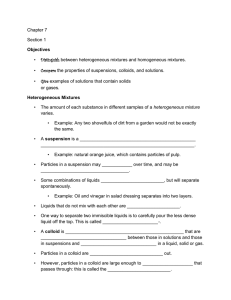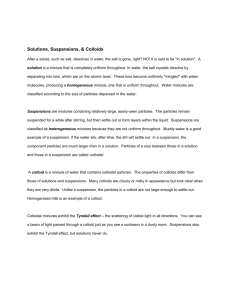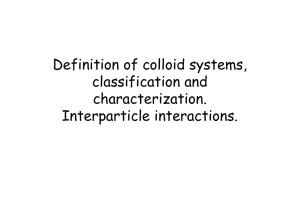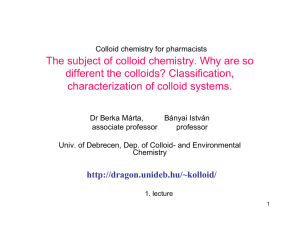Chemistry * The Study of Matter - SchoolWorld an Edline Solution
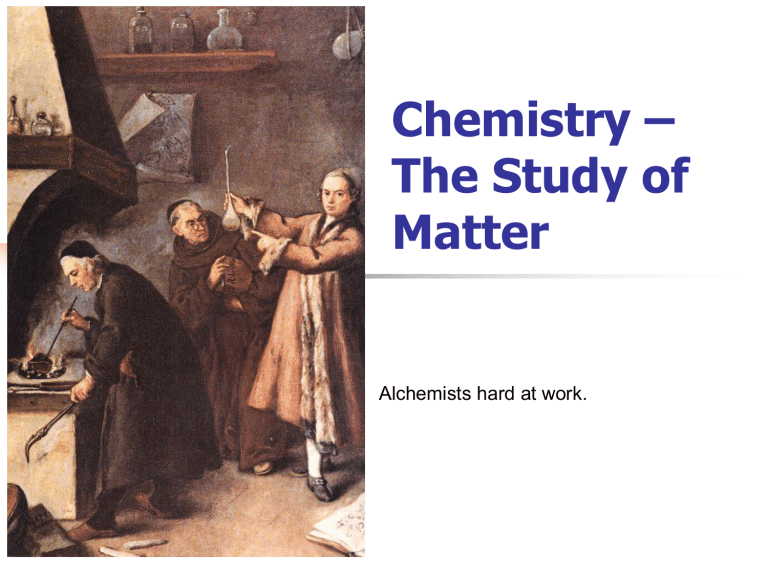
Chemistry –
The Study of
Matter
Alchemists hard at work.
Chemistry
The study of the composition, structure, and properties of matter and the changes it undergoes.
Branches:
Organic
Inorganic
Physical
Analytical
Biochemistry
Theoretical
Research –
What are some ‘modern technologies’ that have impacted the way we live?
Basic Reasearch
Increasing knowledge
Applied Research
Solve a specific problem
Technological Development
Production and use of products to improve quality of life
Matter
4 states of matter
Solids
Liquids
Gases
Plasma
Kinetic Molecular Theory (KMT)
All matter is made of particles that are in constant motion
Solids
Very low KE – particles vibrate
Fixed shape
Fixed volume
Liquids
Low KE – particles can move around but are close together
Variable shape
Fixed volume
Gases
High KE – particles separate and move freely
Variable shape
Variable volume
Plasma
Very high KE
particles collide with enough energy to break into charged particles
Gas-like – variable shape and volume
Ex: stars, fluorescent light bulbs
The Four States of Matter
Solid, Liquid, Gas, and Plasma
Phases of Matter
Intensive v. Extensive
Properties
Intensive property does NOT depend on sample size.
Ex: density, melting point
Extensive property does depend on sample size.
Ex: mass, volume, energy
Physical Properties and
Changes
Can be observed without changing the identity of the substance
Examples:
Color
Viscosity
Melting and boiling points
Thermal conductivity
Electrical conductivity
More Examples:
Specific heat
Luster
State of matter
Phase changes
Magnetism
Solubility
Malleability
Ductility
Crystal Form
Tenacity
Solid
Melting
Freezing
Deposition
Sublimation
Liquid
Condensation
Evaporation
Gas
Chemical Properties and
Changes
Ability to change into a new substance
Reactants become products
Examples:
Flammable
Rusting
Reactivity
Oxidation
Acidity/basisity
Corrosion
Inert
Name that property
Honey and motor oil are very slow to pour. What property bests describes this property???
Viscosity
What property of liquids would you look for to start charcoal for a BBQ????
Flammability
Iron heats up faster than aluminum. What property is this????
Specific Heat
Name that property (more)
Paints made of silver are applied to the back of mirrors. What property of silver is useful????
Luster
The copper on the Statue of Liberty has turned green. What property is causing this???
Corrosion or Oxidation
Jewelry can be pounded to form artistic designs.
What property is this????
Malleability
Name that property (still)
A good frying pan heats food evenly. What property of frying is this????
Thermal Conductivity
Quartz forms hexagons and diamonds form cubes.
What property is this???
Crystal Form
You purchase a clear stone that might be a diamond.
What simple test can you make to determine if it is actually a diamond???
Hardness
Name that property (lastly)
You accidentally drop an iron bolt into a hard-to-reach place in your automobile engine. What property of iron enables you to retrieve the bolt without having to find someone with small hands?
Magnetism
All chemical and physical changes require
ENERGY!!!
Chemical and Physical Properties
Energy & Phase Changes
Heat of vaporization - Amount of heat needed to change a liquid into a gas at its boiling point
Heat of fusion - Amount of heat required to melt a solid at its melting point
Classification Flowchart
yes
MATTER no
Can it be physically separated?
PURE SUBSTANCE MIXTURE yes Is the composition uniform?
Homogeneous
Mixture
(solution) no
Heterogeneous
Mixture yes
Can it be chemically decomposed?
Compound Element no
Colloids Suspensions
Classification of Matter
Examples:
Graphite
Pepper
Sugar (sucrose)
Paint
Soda
Element
Heterogeneous mixture
Compound
Heterogeneous mixture
Solution (homogeneous mixture
Pure Substances
1.
Element
Composed of identical atoms
Ex: Copper wire, aluminum foil
2.
Pure Substances
Compounds
Composed of two or more elements in a fixed ratio
H
O H
H
C
H
C
C
H
O H
C
H
O H
O
H
C
O H
Properties differ from individual elements
Ex: glucose, caffeine
C
H
O H
Mixtures
1.
2.
3.
Combination of 2 or more pure substances
Homogeneous mixtures
Colloids
Heterogeneous mixtures
Suspensions
Mixtures
1.
Homogeneous
AKA: Solution
Very small particles that do not settle
No Tyndall effect
Ex: rubbing alcohol, salt water
Mixtures
2.
Colloid
Heterogeneous
Medium sized particles that do NOT settle
Tyndall effect
Ex: milk
colloid solution
Which glass contains a colloid?
Colloids scatter light, making a beam visible.
Examples of Colloids
Fog, aerosol sprays
Smoke, airborne bacteria
Whipped cream, soap suds
Milk, mayonnaise
Paint, clays, gelatin
Marshmallow, Styrofoam
Butter, cheese
Dispersing
Medium
Gas
Dispersed
Substance
Liquid
Gas
Liquid
Liquid
Liquid
Solid
Solid
Solid
Gas
Liquid
Solid
Gas
Liquid
Colloid Type
Aerosol
Aerosol
Foam
Emulsion
Sol
Solid foam
Solid emulsion
Mixtures
3.
Suspension
Heterogeneous
Large particles that will settle
Tyndall effect
Ex: fresh squeezed lemonade
Mixtures – Colloid, suspension, or solution??
Examples
Mayonnaise
Muddy water
Fog
Salt water
Italian salad dressing
Colloid
Suspension
Colloid
Solution
Suspension
The Periodic Table
Rows – Periods
Columns – Groups or Families
1.
2.
3.
Three main types of elements
Metals
Nonmetals
Metalloids
Metals
Conducts heat and electricity
Malleable
Ductile
Nonmetals
Many are gases at room temperature
Solids are brittle
Metalloids
Touch the stair-step line (except Al)
Some characteristics of metals and nonmetals
Semiconductors


